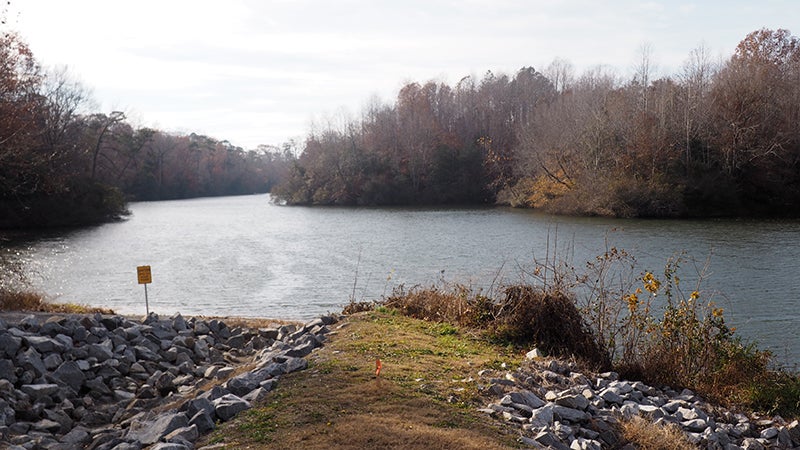Town Council may reconsider decommissioning dam
Published 8:56 pm Tuesday, January 4, 2022

- The Smithfield Lake dam - file photo
Smithfield’s Town Council may end up reversing course on its plans to decommission the Waterworks Road dam.
Bringing the town-owned earthen embankment into compliance with state regulations would cost more than $1.5 million, according to an engineering report by Draper Aden Associates. Citing that cost, the town opted in 2020 to forego the needed repairs, and in 2021, voted to solicit proposals to drain the 26.2-acre Smithfield Lake instead.
According to the recorded minutes of the council’s Public Works Committee meeting on Dec. 27, town staff received several emails and phone calls from area residents with reservations about draining the lake after a Dec. 7 article on the matter appeared in The Smithfield Times.
Among them is Randolph Barlow, who owns land bordering the lake along Foursquare Road just outside the town’s borders.
According to a letter he’d written to be read aloud at the Public Works Committee’s December meeting, the lake drains more than 1,500 acres, which keeps pollutants from entering Mount Holly Creek, the James River, and ultimately, the Chesapeake Bay. Buddy Jones, another landowner whose property adjoins the lake, also spoke during that meeting to express his desire that it be saved. Chief Chris Edwards of the Smithfield Volunteer Fire Department then came forward to state his department uses the lake frequently to fill its tankers when responding to large rural fires.
“I’d hate to see it go; it’s a recreational asset for the town and the county, and it’s very picturesque,” Barlow said, addressing the Town Council at its Jan. 4 meeting.
Edwards, who also spoke during the Jan. 4 meeting, said the SVFD is currently able to pump 1,500 gallons per minute using the lake when filling its tankers, but can only get 600 gallons per minute using the town’s fire hydrants west of the Route 10 bypass.
According to the book “Historical Notes on Isle of Wight County, Virginia” by Helen Haverty King, the dam dates to 1900 when the county’s Circuit Court granted the Smithfield Water Co. a charter to build and maintain a waterworks at the site, which had been an old cotton mill. The State Corporations Commission dissolved the company in 1959, at which time the dam came into the town’s possession.
Since the town transitioned to wells for its drinking water, the dam has served as a boat launch and public park. Problems with the dam began in 2010 when heavy rains weakened the structure, according to past reporting by The Smithfield Times.
The issue resurfaced in 2020 when the town needed another two-year permit from the state to continue operating the dam, and was informed the structure would need additional repairs. The dam is currently operating under a conditional permit from the state, which will expire in February.
According to Smithfield Mayor Carter Williams, the problem mainly concerns the possibility that the dam could again overflow during heavy rain.
“It’s very, very expensive if that thing were to fail,” he said.
Without environmental mitigations, the sediment trapped behind the dam would be washed downstream during future storms if the town were to proceed with its plans to install a culvert in the dam and allow the Mount Holly Creek to resume its normal flow. But those environmental mitigations could drive the cost of draining the lake to $3.2 million, according to Draper Aden’s report – making the culvert option potentially more expensive than repairing the dam.
“If we did drain that lake, and we found some contaminants down there … that’s a big concern of mine,” Williams said.
The council members ultimately voted unanimously that evening to table the matter and remand it back to the Public Works Committee, with Williams’ instruction that they “dig a little deeper” to find a solution, possibly by partnering with the state or Isle of Wight County.
“This is a two-edged sword, and it’s cutting us both ways,” Williams said.




